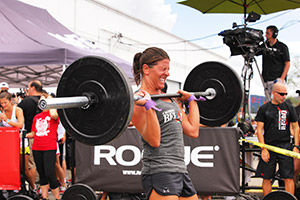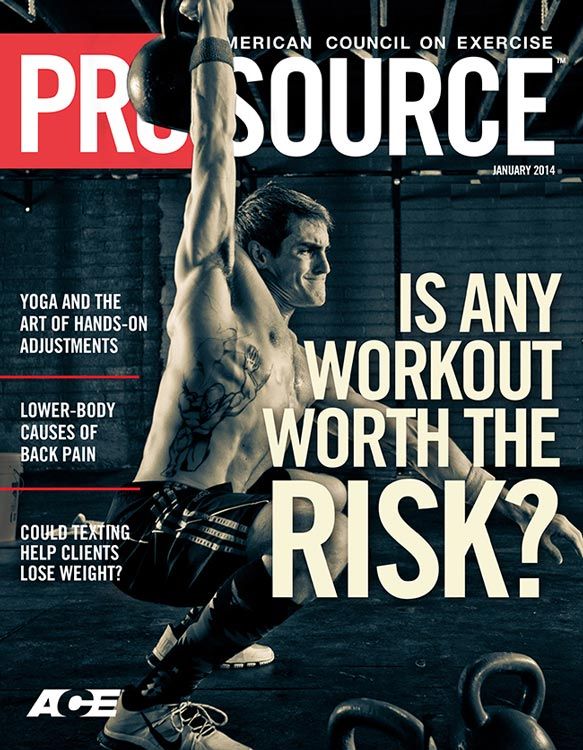
Is Any Workout Worth the Risk?

JOIN THE CONVERSATION!
What do you think about the connection between rhabdomyolsis and high-intensity workout programs like CrossFit? Do you think the threat is overblown or do you caution your clients about the potential dangers? Please share your thoughts on this highly controversial issue in the comments section below.
There’s nothing quite like the topic of CrossFitTM to get people talking—and arguing. After all, people in and out of the fitness industry tend to have pretty strong opinions—both positive and negative—about the popular fitness trend and its ubiquitous WOD (workout of the day).
Mention Uncle Rhabdo (the nickname for rhabdomyolosis, a condition in which damaged muscle tissue breaks down and damages the kidneys) and the conversation is likely to get heated, especially since an article detailing the connection between CrossFit and Uncle Rhabdo went viral a few months ago. Turns out there have been some credible reports tying rhabdomyolosis to the extreme overexertion associated with CrossFit. And although rhabdomyolosis can be caused by any type of high-intensity exercise, it doesn’t help that, given rhabdo’s grave consequences, CrossFit created Uncle Rhabdo, a muscular but exhausted cartoon clown hooked up to a dialysis machine. If this image was just an in-joke among CrossFit participants, their worst transgression would be questionable taste.
Unfortunately, the reported connection between CrossFit and rhabdomyolosis highlights a real problem. People are suffering debilitating, sometimes irreversible damage.
CrossFit, like other extreme conditioning programs such as P90X and Insanity, is grounded in perfectly acceptable high-intensity interval training (HIIT) principles with proven benefits: intensive strength and agility training with lots of calisthenics and power movements (see sidebar: Studies Reflect Benefits of CrossFit). What distinguishes CrossFit is its fostering of a highly competitive, finish-at-all-costs atmosphere. Participants are exhorted to push themselves to their limits. The problem is that, in exploring their limits, some people can cause real damage to themselves.
Studies Reflect
Benefits of CrossFit
While there have been few, if any, peer-reviewed studies on the relative benefits of these ECP programs, two recent studies of CrossFit—one sponsored by ACE and conducted at the University of Wisconsin, La Crosse, the other at Ohio State University—reported that CrossFit and most HIIT forms will help participants burn large numbers of calories.
“Our study showed that it delivers greater increases in aerobic capacity than what we see in traditional aerobic training,” says Bryant. “It burns 15 calories a minute, and it delivers resistance training and balance improvements. It’s a pretty comprehensive approach to training.”
The Ohio State study showed that CrossFit’s high-intensity power-training workouts dramatically improved aerobic fitness and body-fat composition, and the study’s participants achieved significant improvements in aerobic capacity, lost body fat and gained lean muscle.
Rhabdomyolosis Defined
Dr. Eric Robertson, an assistant professor of physical therapy at Regis University in Denver, says that rhabdomyolosis is usually seen in elderly people who have suffered falls or in patients taking statin drugs. It is also seen in trauma victims who have crushed limbs or third-degree burns. However, it’s very rarely seen as a result of physical exertion.
“What happens is that your muscles suffer severe tissue damage," explains Robertson. "Swelling and weakness occur as pressure builds around the remaining muscle cells." These muscle cells, continues Robertson, leach a protein called myoglobin into the bloodstream, where it doesn’t belong. If too much of this protein builds up, the kidneys may be damaged, possibly resulting in renal failure.
Rhabdomyolosis symptoms—whether mild or severe—include bruising, swelling, very tender muscles, soreness that doesn’t dissipate after several days, loss of range of motion, colored urine (or none at all)—and lots of pain. The bad kind. Robertson emphasizes that rhabdomyolosis isn’t the result of cumulative damage. “It can occur instantly—in one training session.”
Sometimes rhabdomyolosis dissipates or improves with treatment. It may linger, or it may leave the victim with lasting kidney and muscle damage. “Once a muscle tears, damaged, fatty scar tissue replaces the injured muscle tissue,” Robertson says. “The result is a permanently damaged muscle, and a decreased ability to strength train.”
All this, of course, is completely antithetical to the purpose of exercise: better health. However, Robertson stresses that rhabdomyolosis isn’t restricted to CrossFit training; it’s correlated with any risky, intense exercise—especially that which uses a lot of eccentric (lengthening) muscle movements. For example, he cites rhabdomyolosis victims who developed the disease after hiking the Grand Canyon, and in military personnel, as the result of forced marching.
Dr. Yuri Feito, assistant professor of exercise science at Kennesaw State University in Georgia, is a CrossFit coach and defends the program’s relative safety—if done with built-in safeguards. He says that rhabdomyolosis often occurs after “unaccustomed exercise of any kind, both in length and total volume of work.” As an example, he offers the case of a 20-year-old man who suffered rhabdomyolosis because he went from playing Ultimate Frisbee recreationally a few times a week to participating in a competitive tournament.
Is the CrossFit "Personality" Prone to Rhabomyolosis?
Getting to the bottom of a connection between rhabdomyolosis and CrossFit involves asking two questions: 1) What kind of personality is attracted to CrossFit (and other extreme forms of high-intensity training)? 2) Why are more Crossfitters exceeding healthy limits of exercise?
The first question is a bit easier to answer, only because there’s much more data to examine: CrossFit has hundreds of thousands of participants working out at more than 7,000 “boxes” (CrossFit’s term for its gyms) worldwide. Dr. Michael F. Bergeron, executive director of the National Youth Sports Health & Safety Institute, asserts that CrossFit is the result of clever marketing of pre-existing, even retro (we’re talking ancient Greek) exercises and our consumer society’s constant need of the new, while Robertson feels that the program’s efficiency—workouts usually last only 30 minutes—is a strong and relatively benign inducement to people in a fast-paced society.

Cedric X. Bryant, Ph.D., F.A.C.S.M., Chief Science Officer for the American Council on Exercise, thinks that the team spirit and camaraderie CrossFit engenders attracts people who might feel bored working out on their own. A big part of the success of CrossFit is that participants feel as though they are part of the CrossFit family and it becomes a part of their identity. In many cases, it helps define and set them apart from other fitness enthusiasts. “That, plus the visibility it gets from ESPN televising the CrossFit Games” likely contribute to its popularity.
The second question—why more Crossfitters are self-destructing—is harder to solve. No studies of the rhabdomyolosis incidents have been done, and the recent spate of cases linked to CrossFit involve people in widely varying states of conditioning, from elite athletes to what Bryant calls “former competitive athletes who have become inactive, but engage in CrossFit because it triggers their competitive urge.”
Feito leans toward the latter interpretation: “The reports suggest that many rhabdo victims are people who are fit for a certain training modality—a triathlete, soccer player or wrestler—but who are new to CrossFit and want to bump up the intensity.” Robertson agrees: “Most people who experience exertional rhabdomyolosis are very fit. This is not a case of out-of-shape newbies doing too much.”
5 Tips for Avoiding Rhabdomyolosis
The following advice from Cedric X. Bryant, Ph.D., ACE's Chief Science Officer, should be given to clients who participate in CrossFit or other high-intensity workout programs:
1. Progress workouts gradually.
2. Respect your fitness level and know your limits.
3. Stay hydrated.
4. Use caution when performing a large number of eccentric-focused exercises, such as kettlebell swings and thrusters.
5. Know the signs of rhabdomyolosis, which may include: extreme muscle pain disproportionate to the soreness expected from the workout; swelling in the affected limb(s); dark-colored urine or decreased urine output. Anyone experiencing these symptoms following a high-intensity workout should seek immediate medical attention.
So who’s ultimately responsible for Uncle Rhabdo? CrossFit advocates claim that the company not only makes clear the potential dangers of its “Workout of the Day,” but also specifically discusses rhabdomyolosis in its literature and materials for trainers, and warns against it. Moreover, they claim that the recent public brouhaha happened only because they’ve brought rhabdomyolosis to the public’s attention.
Robertson indicates that improper coaching could be responsible for at least some of the cases. “Some people who have reached out to me said that ‘my CrossFit coach was intense—and I didn’t want to be the one to say it’s too much or too hard.’ So to some extent it’s an outgrowth of a group dynamic. Other instances involved people who finished their workouts just fine, except that the workout concentrated on one muscle—like a colleague who did hundreds of reps of triceps exercises only to see her arm blow up like a balloon.”
Is it Worth the Risk?
Until science chimes in on this issue, people who are currently engaged in CrossFit or considering doing so should remember to ask the following questions, which Robertson recently posted on the website Medium: “Is this workout worth the risk? Can the culture adapt to one that embraces safe training principles? Do coaches truly have the ability to detect what a proper training load is for their athletes?”
It all comes down to playing it safe. “It’s fine to have a healthy competition, but you have to make sure you stay within the boundaries of your physiological condition,” Bryant says. “There should be a shared responsibility between the CrossFit coach and client. The coach must induce the client to put forth effort, but it’s up to the client to listen to her own body and let the coach know when she’s hitting her limits. Most good coaches will be able to make modifications in form.” Dr. Bryant offers additional tips for avoiding rhabdomyolosis in the sidebar, above.
“You’re asking people to move through a complete range of motion at speed,” says Anthony Wall, ACE's Director of Professional Education. “It is essential that participants first build a strong foundation of stability and mobility” before attempting any type of high-intensity training.
Here are Robertson’s suggestions for newcomers to CrossFit or any other type of HIIT: “First, stay hydrated. Second, use good judgment when you’re increasing reps. Even if you’re very fit, if you want to do 100, don’t do them straight through. Build up to that number and take rest breaks.” Sabrena Merill, exercise physiologist, ACE Education Content Development Expert and CrossFit enthusiast offers these five steps for anyone interested in trying CrossFit or other high-intensity workout programs for the first time.
Bryant advises trainers to gauge the pre-exercise level of new clients and give them an appropriate level of intensity. “I would start a client new to CrossFit with one or two weekly workouts,” he says. “Once they show they can adapt to that frequency, you can add more sessions. For example, I would do a CrossFit workout on Tuesday and Friday, and on the following days I’d do lower- to moderate-intensity cardio work combined with some stretching for recovery. On one of the days before a CrossFit workout, I’d do an intense cardio workout. And I’d have two recovery days devoted to rest or some light yoga or stretching.”
Fitness professionals need not eliminate CrossFit (and any other high-intensity exercise programs) from their offered workout regimens, says Bryant, but they must be attuned to the dangers associated with allowing their clients to exceed the limits of healthy exercise and advise them accordingly.

More Articles
- ProSource™: January 2014
New Year, New Message! Help Your Clients Maintain, Don’t Gain More Weight
Contributor
- ProSource™: January 2014
Lower-body Causes of Back Pain (and How to Fix Them)
Health and Fitness Expert




 by
by 

